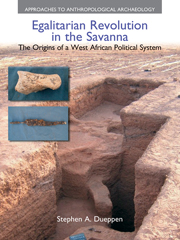Book contents
- Frontmatter
- Dedication
- Contents
- List of Figures
- List of Tables
- Acknowledgments
- 1 Decentralization and the Evolution of Egalitarian Behaviors in Sedentary Societies
- 2 Ancient Villages in the Niger Bend: Context and Methods for Exploring the Voltaic Region
- 3 Ethnographic Perspectives on Western Burkina Faso: A Survey
- 4 Kirikongo: An Introduction to the Site, the Setting, and the Research Design
- 5 The West African Environmental Setting: Kirikongo in Ecological Context
- 6 Stratigraphies and Depositional Episodes: The Excavations
- 7 Relative Chronology: Ceramics
- 8 Community Growth at Kirikongo: The Spatial and Temporal Setting
- 9 Early Sedentary Life in the Voltaic Region: Defining a ‘Voltaic Tradition’
- 10 Craft Production at Kirikongo: The Origins, Development and Reinterpretation of Specialization
- 11 Herding, Farming, and Ritual Sacrifice: The Economy from Kirikongo
- 12 Death and Ritual Objects at Kirikongo: House-Based Social Differentiation
- 13 Archaeological Patterns and Social Process: Reconstructing Changing Life at Kirikongo
- 14 Land, Spiritual Power, and Gerontocracy: An Exploration of the Roots of Egalitarian Revolution in the Western Voltaic Region
- 15 Hierarchy and Egalitarianism within the Niger Bend: Revolution and the Triumph of Communalism
- Bibliography
- Index
13 - Archaeological Patterns and Social Process: Reconstructing Changing Life at Kirikongo
- Frontmatter
- Dedication
- Contents
- List of Figures
- List of Tables
- Acknowledgments
- 1 Decentralization and the Evolution of Egalitarian Behaviors in Sedentary Societies
- 2 Ancient Villages in the Niger Bend: Context and Methods for Exploring the Voltaic Region
- 3 Ethnographic Perspectives on Western Burkina Faso: A Survey
- 4 Kirikongo: An Introduction to the Site, the Setting, and the Research Design
- 5 The West African Environmental Setting: Kirikongo in Ecological Context
- 6 Stratigraphies and Depositional Episodes: The Excavations
- 7 Relative Chronology: Ceramics
- 8 Community Growth at Kirikongo: The Spatial and Temporal Setting
- 9 Early Sedentary Life in the Voltaic Region: Defining a ‘Voltaic Tradition’
- 10 Craft Production at Kirikongo: The Origins, Development and Reinterpretation of Specialization
- 11 Herding, Farming, and Ritual Sacrifice: The Economy from Kirikongo
- 12 Death and Ritual Objects at Kirikongo: House-Based Social Differentiation
- 13 Archaeological Patterns and Social Process: Reconstructing Changing Life at Kirikongo
- 14 Land, Spiritual Power, and Gerontocracy: An Exploration of the Roots of Egalitarian Revolution in the Western Voltaic Region
- 15 Hierarchy and Egalitarianism within the Niger Bend: Revolution and the Triumph of Communalism
- Bibliography
- Index
Summary
In archaeological interpretations, a holistic view of societal change requires diverse lines of evidence, that when combined together paint a detailed portrait of social groups over time. The following temporal trends in archaeological patterns are here examined: dispersed mounds to clustered mounds, generalized households to specialized households, closed compounds to open neighborhoods (room blocks), bridewealth and animal sacrifice to bride service and animal sacrifice, garden hunting to collective hunting, the emergence of ritual architecture, restricted cemetery burial to a generalized mortuary program, and possible regional integration to local autonomy. The understandings derived from the following discussions are critical to the interpretations advanced in subsequent chapters. (A summary of the information in this chapter is available in Table 13.1.)
Spatial Organization: From Independent Mounds to a Clustered Village
Changes in the spatial organization of Kirikongo suggest dramatic transformations in the community and land tenure system over time. During Yellow I to mid-Yellow II, Mounds 1, 4 and 11 were dispersed (ca. 200 meters apart) in a north/south line following the edge of the laterite ridge. Their respective locations, above seasonal flooding, provided each with access to deep farming soils. In the ethnographic survey, when compounds were dispersed they were self-sufficient and independent entities in relation to a village. Concerning land tenure, the distribution of mounds adjacent to deep soils suggests a need to assert access to fertile land, and it is not clear if the inhabitants of Mound 4 controlled (or exercised control over) access to land until the period after Mound 11 was founded.
- Type
- Chapter
- Information
- Egalitarian Revolution in the SavannaThe Origins of a West African Political System, pp. 274 - 292Publisher: Acumen PublishingPrint publication year: 2012



